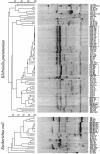Prevalence and molecular epidemiology of CTX-M extended-spectrum beta-lactamase-producing Escherichia coli and Klebsiella pneumoniae in Russian hospitals
- PMID: 14638473
- PMCID: PMC296190
- DOI: 10.1128/AAC.47.12.3724-3732.2003
Prevalence and molecular epidemiology of CTX-M extended-spectrum beta-lactamase-producing Escherichia coli and Klebsiella pneumoniae in Russian hospitals
Abstract
A total of 904 consecutive nosocomial isolates of Escherichia coli and Klebsiella pneumoniae collected from 28 Russian hospitals were screened for production of extended-spectrum beta-lactamases (ESBLs). The ESBL phenotype was detected in 78 (15.8%) E. coli and 248 (60.8%) K. pneumoniae isolates. One hundred fifteen isolates carried the genes for CTX-M-type beta-lactamases, which, as shown by PCR-restriction fragment length polymorphism analysis, were distributed into the two genetic groups of CTX-M-1 (93%)- and CTX-M-2 (7%)-related enzymes. Isolates producing the enzymes of the first group were found in 20 hospitals from geographically distant regions of the country and were characterized by considerable diversity of genetic types, as was demonstrated by enterobacterial repetitive consensus PCR typing. Within this group the CTX-M-3 and the CTX-M-15 beta-lactamases were identified. In contrast, the enzymes of the CTX-M-2 group (namely, CTX-M-5) were detected only in eight clonally related E. coli isolates from a single hospital. Notably, the levels of resistance to ceftazidime were remarkably variable among the CTX-M producers. This study provides further evidence of the global dissemination of CTX-M type ESBLs and emphasizes the need for their epidemiological monitoring.
Figures



References
-
- Baraniak, A., J. Fiett, W. Hryniewicz, P. Nordmann, and M. Gniadkowski. 2002. Ceftazidime-hydrolysing CTX-M-15 extended-spectrum β-lactamase (ESBL) in Poland. J. Antimicrob. Chemother. 50:393-396. - PubMed
-
- Bauernfeind, A., H. Grimm, and S. Schweighart. 1990. A new plasmidic cefotaximase in a clinical isolate of Escherichia coli. Infection 18:294-298. - PubMed
-
- Bauernfeind, A., J. M. Casellas, and M. Goldberg. 1992. A new plasmidic cefotaximase from patients infected with Salmonella typhimurium. Infection 20:158-163. - PubMed
MeSH terms
Substances
LinkOut - more resources
Full Text Sources
Other Literature Sources
Medical

